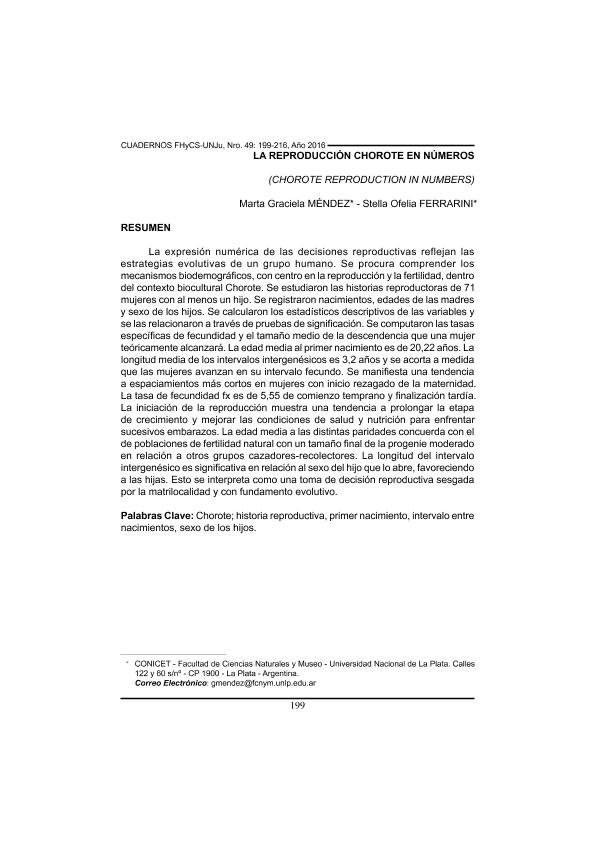Artículo
La expresión numérica de las decisiones reproductivas reflejan lasestrategias evolutivas de un grupo humano. Se procura comprender losmecanismos biodemográficos, con centro en la reproducción y la fertilidad, dentro del contexto biocultural Chorote. Se estudiaron las historias reproductoras de 71 mujeres con al menos un hijo. Se registraron nacimientos, edades de las madres y sexo de los hijos. Se calcularon los estadísticos descriptivos de las variables y se las relacionaron a través de pruebas de significación. Se computaron las tasas específicas de fecundidad y el tamaño medio de la descendencia que una mujer teóricamente alcanzará. La edad media al primer nacimiento es de 20,22 años. La longitud media de los intervalos intergenésicos es 3,2 años y se acorta a medida que las mujeres avanzan en su intervalo fecundo. Se manifiesta una tendencia a espaciamientos más cortos en mujeres con inicio rezagado de la maternidad. La tasa de fecundidad fx es de 5,55 de comienzo temprano y finalización tardía. La iniciación de la reproducción muestra una tendencia a prolongar la etapa de crecimiento y mejorar las condiciones de salud y nutrición para enfrentar sucesivos embarazos. La edad media a las distintas paridades concuerda con elde poblaciones de fertilidad natural con un tamaño final de la progenie moderado en relación a otros grupos cazadores-recolectores. La longitud del intervalo intergenésico es significativa en relación al sexo del hijo que lo abre, favoreciendo a las hijas. Esto se interpreta como una toma de decisión reproductiva sesgada por la matrilocalidad y con fundamento evolutivo. The numeric expression of reproductive decisions reflects the evolutionary strategies of a human group. We tried to understand the bio-demographic mechanisms, with center in reproduction and fertility, inside the bioculturalChorote context. The reproductive histories of 71 women were studied with at least a son. It was registered births, mothers' ages and the children's sex. Descriptive statistical of the variables were calculated and they were related through significance tests. The specific rates of fecundity and the average number of the descendant that a woman theoretically will reach were computed. The mean age at the first birth is of 20,2 years. The average length of the intergenesic intervals is 3,2 years and it shortens as the women advance in its fertile interval. A tendency is manifested to shorter spacing in women with beginning straggler of the maternity. Fertility rate fx is 5,5, with early starting and late ending. The initiation of the reproduction shows a tendency to prolong the stage of growth and to improve health and nutrition conditions to face successive pregnancies. The mean age of the different parities agrees with that of populations of natural fertility with a final size of the offspring moderated in relation to other group's hunter-gatherers. The longitude of the intergenesic interval is significant in relation to the child's sex that opens it, favoring the daughters. It is interpreted as a reproductive decision slanted by the matrilocality with evolutionary foundation.
La reproducción Chorote en números
Título:
Chorote reproduction in numbers
Fecha de publicación:
06/2016
Editorial:
Universidad Nacional de Jujuy. Facultad de Humanidades y Ciencias Sociales
Revista:
Cuadernos de la Facultad de Humanidades y Ciencias Sociales
ISSN:
0327-1471
Idioma:
Español
Tipo de recurso:
Artículo publicado
Clasificación temática:
Resumen
Archivos asociados
Licencia
Identificadores
Colecciones
Articulos(CCT - LA PLATA)
Articulos de CTRO.CIENTIFICO TECNOL.CONICET - LA PLATA
Articulos de CTRO.CIENTIFICO TECNOL.CONICET - LA PLATA
Citación
Mendez, Marta Graciela; Ferrarini, Stella Ofelia; La reproducción Chorote en números; Universidad Nacional de Jujuy. Facultad de Humanidades y Ciencias Sociales; Cuadernos de la Facultad de Humanidades y Ciencias Sociales; 49; 6-2016; 199-216
Compartir




